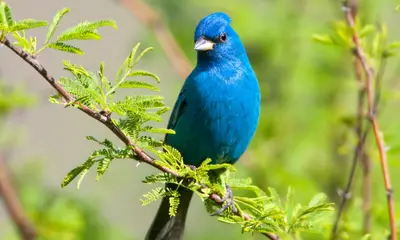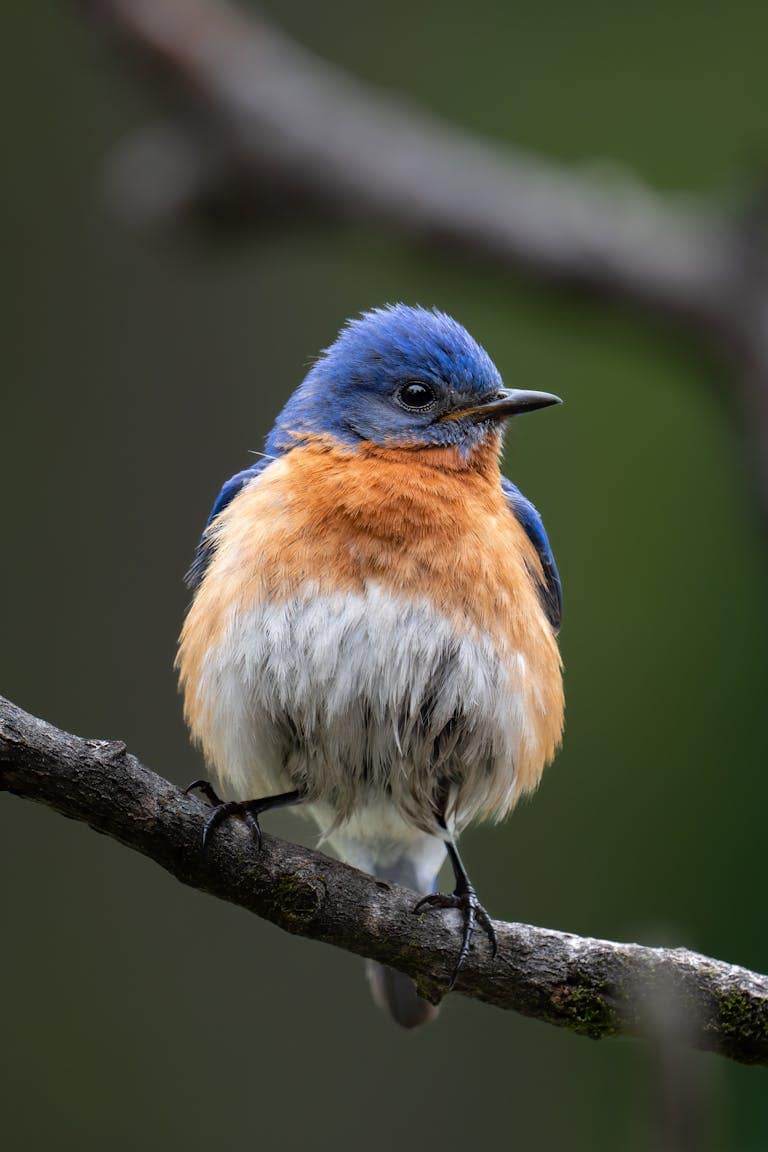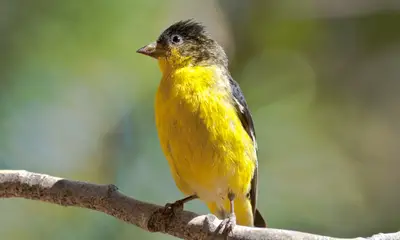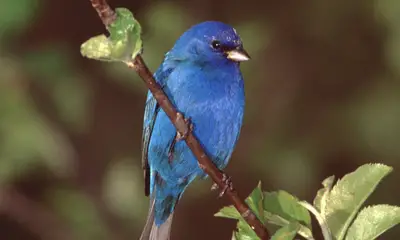7 Amazing BLUE Birds With ORANGE Chest (Photos & Key Facts)
Did you spot a blue bird with an orange chest and would like to know what species it was?
Identifying blue and orange birds is not as easy as it seems, since there are several different types of birds in North America that have this color combination.
To help you identify the bird that you saw, we’ve put together this ID guide that covers the most common North American birds that are blue with an orange chest.
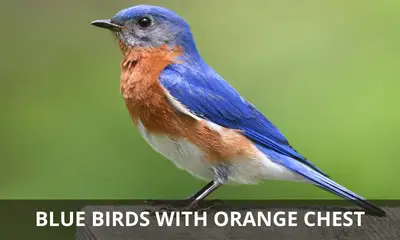
What are the types of blue birds with orange chests?
There are 7 types of blue birds with orange chests in North America, which are all described in full detail below.
Eastern Bluebird
Scientific name: Sialia sialis
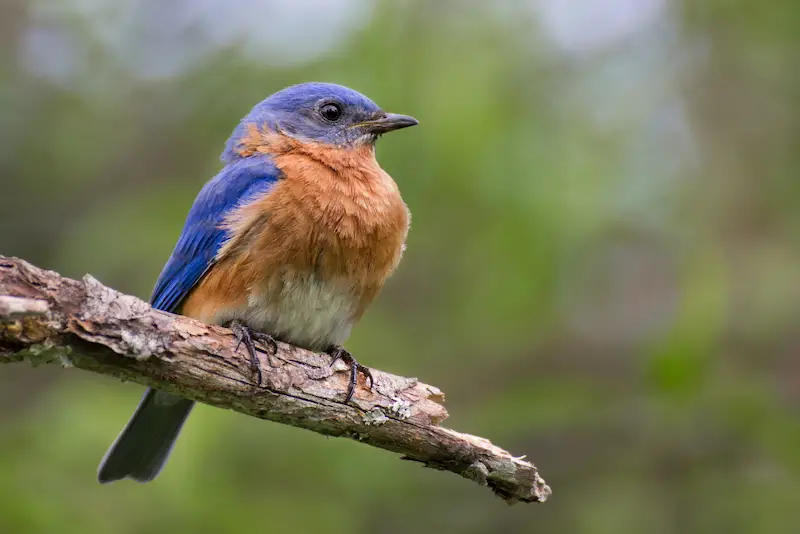
The Eastern Bluebird is a rare to locally common summer visitor in the eastern United States.
The upperparts of adult male Eastern Bluebirds are a rich shade of admiral blue. The bright blue coloration of these birds also extends into their wings and tails.
The partial orange collar of males can create the impression of having a cap on their heads. Male Eastern Bluebirds have a reddish orange chest, which contrasts with their deep blue upperparts.
Adult females and juvenile birds have a more grayish-brown color. However, adult female birds also have a blue tail and blue wing feathers, as well as a rust orange belly and flanks.
This familiar blue bird has a reddish orange chest
The Eastern Bluebird is a migratory bird in the northern part of its range, but can be seen year-round in the southern part of the United States. Northern populations winter in Mexico.
This bird nests in holes, and competes with House Sparrows and European Starlings for nesting sites.
During their fall migration, these bluebirds can be seen in flocks that like to feed on fruits and berries.
The population of Eastern Bluebirds underwent a dramatic decline at the end of last century, due to lack of nesting holes and competition with European Starlings.
But largely thanks to the efforts of numerous citizens providing nest boxes for Eastern Bluebirds, these beautiful blue birds are a common sight once more.
While this bird species originally used a Woodpecker cavity for nesting, they now readily accept artificial nest sites to raise their brood.
You can attract these bluebirds to your backyard by offering mealworms at your bird feeder.
Western Bluebird
Scientific name: Sialia mexicana
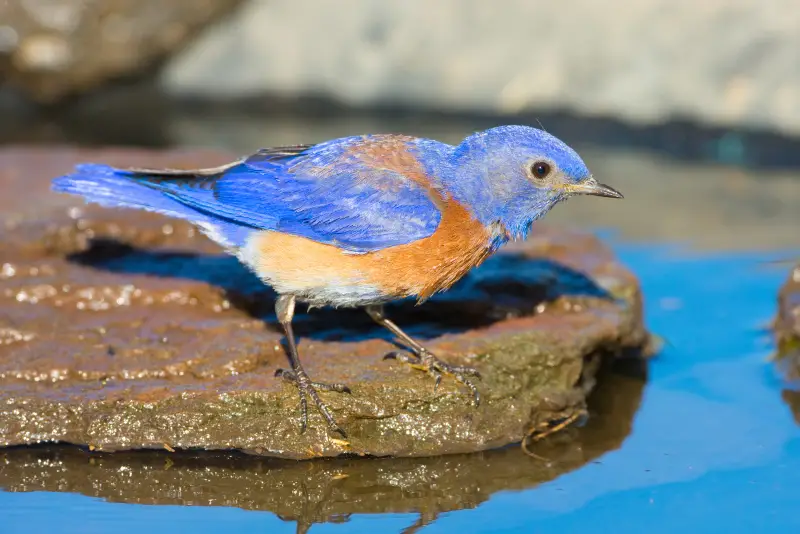
The male Western Bluebird has a stunning plumage, which consists of dazzling blue upperparts and rich chestnut orange breast and flanks.
Overall, it is quite similar to the appearance of its near relative, the Eastern Bluebird. However, unlike the Eastern Bluebird, the Western Bluebird has an orange collar that extends all the way around its head
The Western Bluebird is a breeding bird in the western half of the USA, and its range is largely non-overlapping with that of the Eastern Bluebird.
Females and juvenile birds have more muted colors with a brownish back, a light gray throat, and pale orange chest.
During the breeding season, the Western Bluebird is most commonly found in open forests that contain both conifers and deciduous trees.
During the summer, its diet mainly consists of insects, but in the winter it switches to eating mostly berries.
It is a migratory species in the northern part of its range, but can be seen all year round in the southwestern part of the United States.
Barn Swallow
Scientific name: Hirundo rustica
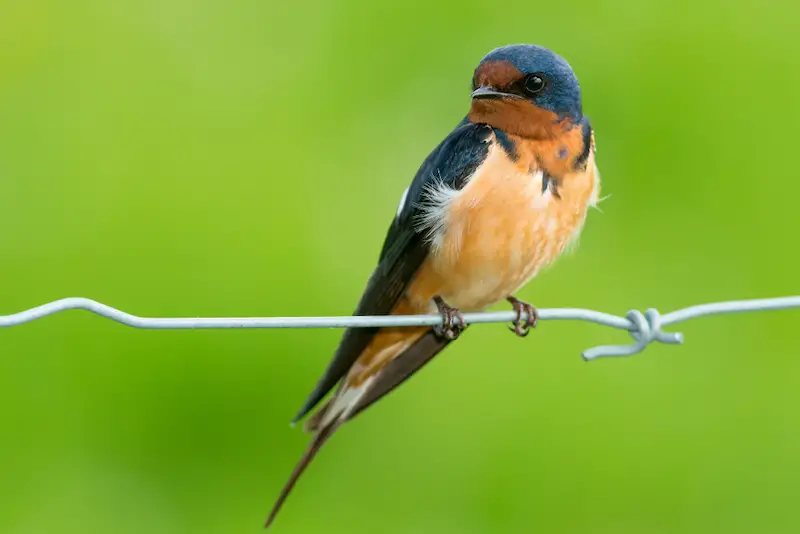
The Barn Swallow inhabits nearly all of North America south of the Arctic circle and may be found in a wide variety of habitats.
While this bird has dark iridescent blue upperparts, its underside is reddish-orange, including a deep orange forehead and throat, as well as a light reddish-orange belly.
The deeply forked tail of Barn Swallows is another great feature you can use to identify this bird.
However, keep in mind that immature barn swallows have a duller plumage than adults, as well as a shorter tail that is less forked.
The Barn Swallow used to nest in caves and hollow trees, but nowadays it prefers to do so beneath the overhangs of buildings and bridges, as well as inside barns (which explains how it got its name).
Barn Swallows are still a reasonably common sight in most areas. However, the overall numbers of Barn Swallows have been steadily decreasing, especially in the northern section of their range.
This decline is likely a result of the loss of foraging areas and nesting opportunities.
The Barn Swallow feeds on flying insects, such as mosquitoes and flies, and catches them closer to the ground than other species of swallows. In its winter quarters it also feeds on termites.
It is a strictly migratory bird, and spends the winter in Central and Southern America.
Red-breasted Nuthatch
Scientific name: Sitta canadensis
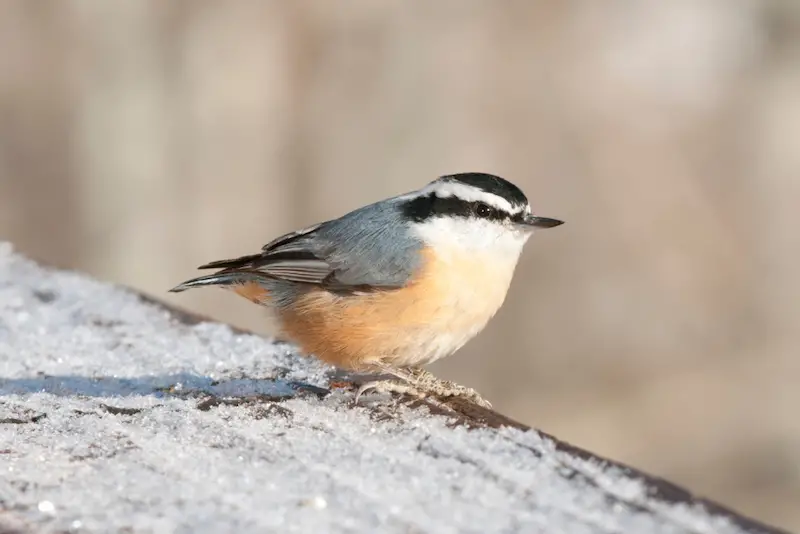
The Red-breasted Nuthatch is a common visitor at bird feeders, and also accepts nesting boxes that are put up well before the breeding season.
Adult male Red-breasted Nuthatches have rusty orange underparts, as well as blue gray upperparts and a black eye stripe that contrasts with their white cheeks and eyebrows.
Females and immature birds are also blue gray on top, but have slightly paler orange underparts.
In the eastern part of their range, Red-breasted Nuthatches can be found in coniferous forests in lowlands and hills. In the western part, however, they inhabit mountainous areas.
The Red-breasted Nuthatch is a talented climber, and can use its robust claws to climb in any direction on a tree trunk.
This bird is often observed upside down while feeding on insects it excavates from under the tree’s bark.
In addition to eating insects, this blue bird also feeds on seeds and nuts, which it can store for later use, similar to squirrels.
In order to open a nut, it will place the nut in a crack of bark, and then hammer it with its beak.
Nuthatches dig out nest cavities in pine trees, and also use mud to adjust the size of the opening.
In most areas of North America, Red-breasted Nuthatches can be found year round, except for the southernmost parts, where they only occur during the winter.
Lazuli Bunting
Scientific name: Passerina amoena
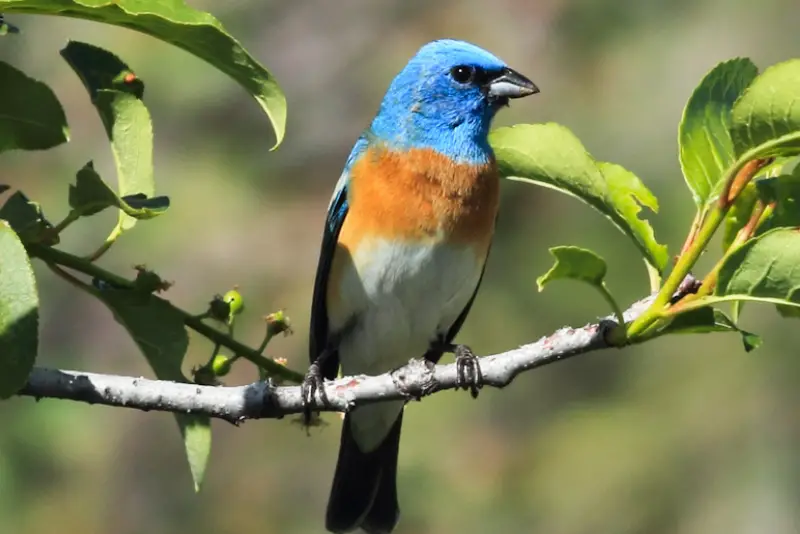
The Lazuli Bunting is a gorgeous songbird of the western United States that visits and breeds in the western United States during the summer.
The hood, neck, and rump of adult males are brilliant blue, while the wings are dark gray with a white wingbar. Males also have a chestnut orange chest and a white belly throughout the summer months.
Female birds are buff-brown in color with glossy black wings and a pale blue rump.
This blue bird may be found in the western US during the breeding season, which runs from May to August, before migrating to Mexico for the winter.
Belted Kingfisher
Scientific name: Megaceryle alcyon
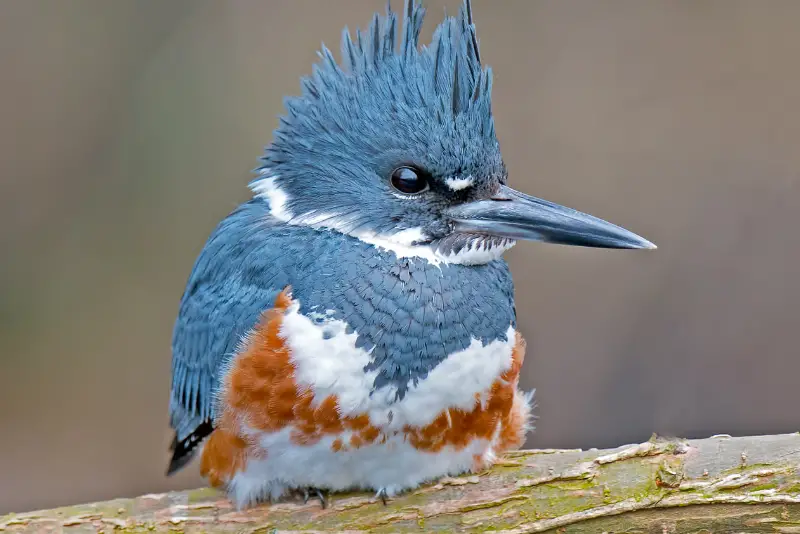
While adult male Belted Kingfishers are teal blue on top, and white on the bottom, female birds have a combination of blue upperparts and rufous orange chest and flanks.
The Belted Kingfisher looks superficially similar to a Blue Jay, due to its grayish blue upperside. However, the Belted Kingfisher is darker than a Jay, and is also more likely to be found close to water.
This kingfisher prefers habitats directly adjacent to lakes and rivers, where it hunts for fish by diving headfirst into the water.
Only female Belted Kingfishers are blue with an orange chest.
This blue bird is a partial migratory bird, but can be seen year round in southern parts of its range.
During harsh winters, northern Belted Kingfishers migrate to southern parts of the United States.
This white and blue-colored bird feeds almost exclusively on small fish, and is therefore rarely seen far away from water.
Varied Thrush
Scientific name: Ixoreus naevius
The Varied Thrush is a bird of the Pacific Northwest, breeding in a broad coastal band from eastern Oregon up to Alaska.
Both sexes are similar, and have a blue back and bright orange throat and belly, contrasting with a striking black necklace that is more pale in female birds.
The male also has a grayish black head with an orange eyebrow stripe.
This is a migratory bird in the northern parts of its range, and during periods of heavy snowfall, it is a common guest at bird feeders offering seed mixes.
In winter it can be found in a wide range of habitats, including urban gardens. But during the breeding season it favors mature forests with both deciduous and coniferous trees.
The best way to identify a Varied Thrush is by its melodious whistling song that is most often heard at dusk and dawn.
Final remarks
In summary, here are 7 types of blue birds that have an orange chest:
- Eastern Bluebird
- Western Bluebird
- Barn Swallow
- Red-breasted Nuthatch
- Lazuli Bunting
- Belted Kingfisher
- Varied Thrush
If you’ve spotted one of these birds, but aren’t sure which species it was, check our detailed ID guide with photos above.
If you enjoyed this article, check out our guide to the blue birds of Colorado.


